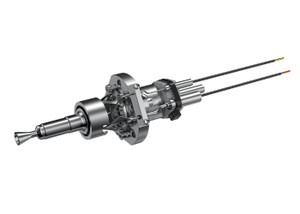
1 N HPGP Thruster
ECAPS
The 22 N High Performance Green Monopropellant (HPGP) thruster enables high thrust apogee, reaction control and proximity operations maneuvering medium-large spacecraft and kick stages.
The 22 N HPGP Thruster also enables high thrust delta-V maneuvers and AOCS for small-medium class spacecraft and reaction control for large spacecraft.
The thruster operates on LMP-103S low-toxicity monopropellant with 1.3C the density-Isp of hydrazine. Additionally, LMP-103S offers up to 72% cheaper spacecraft loading as compared to hydrazine, reducing the total life-cycle cost of the mission.
The propellant is long term storable (>15 years) and enables "fuel at the factory" for rapid response satelliltes. Over 31 satellites are presently flying HPGP technology (as of 2024).
Mechanical Interface:

| Parameter | Value |
|---|---|
| Thrust Range | 5.5 to 22 N |
| Propellant | LMP-103S |
| Mass | 1.0 Kg |
| Length | 260 mm |
| Flow Control Valve Type | Solenoid |
| Pull-in Voltage | 28 (+/- 4) VDC |
| Holding Voltage | 10 (+/- 1) VDC |
| Nominal Reactor Pre-heating Voltage | 28 VDC |
| Regulated Reactor Pre-heating Power | 36 to 50 W |
| Minimum Impulse Bit | < 0.44 Ns |
| Pulses | 50,000 (qualification level) |
| Propellant Throughput | 150 kg (qualification level) |
| Longest Continuous Firing Time | 45 mins (qualification level) |
| Accumulated Firing Time | 3 hrs (qualification level) |
| Firing Sequences | 282 (qualification level) |